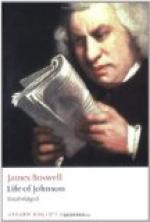The eight crosses, which Martin mentions as pyramids for deceased ladies, stood in a semicircular line, which contained within it the chapel. They marked out the boundaries of the sacred territory within which an asylum was to be had. One of them, which we observed upon our landing, made the first point of the semicircle. There are few of them now remaining. A good way farther north, there is a row of buildings about four feet high; they run from the shore on the east along the top of a pretty high eminence, and so down to the shore on the west, in much the same direction with the crosses. Rasay took them to be the marks for the asylum; but Malcolm thought them to be false sentinels, a common deception, of which instances occur in Martin, to make invaders imagine an island better guarded. Mr. Donald M’Queen, justly in my opinion, supposed the crosses which form the inner circle to be the church’s land-marks.
The south end of the island is much covered with large stones or rocky strata. The laird has enclosed and planted part of it with firs, and he shewed me a considerable space marked out for additional plantations.
Dun Can is a mountain three computed miles from the laird’s house. The ascent to it is by consecutive risings, if that expression may be used when vallies intervene, so that there is but a short rise at once; but it is certainly very high above the sea. The palm of altitude is disputed for by the people of Rasay and those of Sky; the former contending for Dun Can, the latter for the mountains in Sky, over against it. We went up the east side of Dun Can pretty easily. It is mostly rocks all around, the points of which hem the summit of it. Sailors, to whom it was a good object as they pass along, call it Rasay’s cap. Before we reached this mountain, we passed by two lakes. Of the first, Malcolm told me a strange fabulous tradition. He said, there was a wild beast in it, a sea horse, which came and devoured a man’s daughter; upon which the man lighted a great fire, and had a sow roasted at it, the smell of which attracted the monster. In the fire was put a spit. The man lay concealed behind a low wall of loose stones, and he had an avenue formed for the monster, with two rows of large flat stones, which extended from the fire over the summit of the hill, till it reached the side of the loch. The monster came, and the man with the red-hot spit destroyed it. Malcolm shewed me the little hiding-place, and the rows of stones. He did not laugh when he told this story. I recollect having seen in the Scots Magazine, several years ago, a poem upon a similar tale, perhaps the same, translated from the Erse, or Irish, called Albin and the Daughter of Mey.




